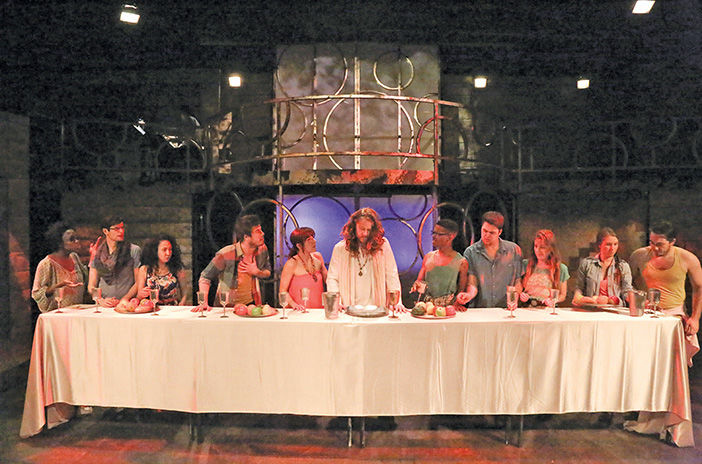A loudly lyrical Lenten meditation is taking place at the MET Theatre in Hollywood. The DOMA production of Andrew Lloyd Webber and Tim Rice’s rock opera “Jesus Christ Superstar” is an exuberant musical, a near-perfect gem of theatrical virtuosity.
Excoriated as blasphemy by some Christians in the 1970s, “Superstar” was generally welcomed by young, post-Vatican II Catholics already weary of slipshod liturgies and insipid, Kumbaya-esque ditties where relevance displaced reverence at Mass. Over time, the driving music and idiosyncratic lyrics of “Superstar” have stimulated many believers seeking Jesus beyond the stained glass to reread the Gospels.
Controversy has subsided, but I’m sure some people still regard “Superstar” as Bach’s “Saint Matthew Passion” performed on the Bizarro World.
The libretto remains somewhat thorny for Catholics, continually harping on Jesus as “an ordinary man,” then teasingly hinting at divinity, such as with Mary Magdalene’s comment following Peter’s denials: “That’s what he told us you would do; I wonder how he knew.”
Before curtain on opening night, Marco Gomez, director, and Dolf Ramos, producer, announced that this is “not a traditional version” of the piece. True, cast members aren’t draped in tunics and cloaks. Gomez, however, follows another tradition: presenting “Superstar” as a modern-dress parable: Jesus, symbolic of the Pure Rock Star, opposes the Evil Suits — rapacious recording company executives who seduce, then destroy artists in the name of greed.
Completely utilizing the MET’s performance space, “Jesus Christ Superstar” is bursting with energy, well worth the price of admission, if only to delight in Angela Todaro’s dynamic choreography, superbly performed by a lively, sparkling, well-disciplined ensemble. Opulently bedecked in Lauren Oppelt’s often flamboyant costumes, they sing and dance up a storm all over John lacovelli’s well-conceived sets. A sly, brilliantly topical directorial touch has them, as members of the press, shoving cell phone-sticks at Jesus in place of microphones as they interview him.
One small caveat amidst all the musical splendor — the musicians are marvelous and the music is vibrant, the heart of the show. Yet every so often the band drowns out the voices of the principals. This needs fixing. It’s opera, for pity’s sake. Audience members — even while singing along under their breath — need to hear the lyrics.
More good points: Kelly Brighton hits a sardonic bulls-eye as Pontius Pilate, vacillating behind an eyepatch. Andrew Diego is a treacherously resolute Caiaphas — what a bass! The wonderfully animated Michelle Holmes trots alongside as Annas. Happily, DOMA is performing the full score. Peter thus has two songs, allowing audiences twice the delight as Blair Grotbeck’s superb baritone fills the house.
The most-awaited scene in any “Superstar” production is the appearance of the Tetrarch of Galilee, and Venny Carranza wows the audience with his over-the-top impersonation of Herod Antipas. He and members of his court outrageously strut their stuff in time to Herod’s raucous ridicule: “If you are the Christ, yes, the great Jesus Christ, prove me that you’re divine, change my water into wine.” It’s entirely appropriate that two of his barely-clad male courtiers contemptuously plop a crown of thorns on the savior’s brow.
The crucifixion is reverently showcased. Panels atop the set open, revealing Jesus on the cross, hoisted into what resembles a tabernacle. Catholics will find it reminiscent of the sacred host enthroned in a monstrance during eucharistic adoration.
The principal actors are all good. Nate Parker as Jesus has real presence, though he’s a bit too languid in his white Palm Beach suit. The very attractive Renee Cohen as Mary Magdalene sings beautifully, yet she’s a smidge too laid back. Jeremy Saje as a gangsta Judas breathes new life into the role, and Graham Kurtz projects an energetic aura as Simon Zelotes (misspelled “Zealotes” in the program — no one told the printer that it’s Greek).
Directorially, however, it was annoying to watch Jesus only slightly cleanse the Temple. He knocks over a small table, pulls down a banner — and it’s over.
That’s rage?
Jesus, here, must be dynamic! An onstage whirlwind blasting all before him, fuelling Annas and Caiaphas’ frantic desire to be rid of him. This is where Mary Magdalene’s tender devotion offsets Jesus’ wrath — something not that apparent. And the ballad, “I Don’t Know How to Love Him,” well sung by Miss Cohen, should have been a showstopper but, lacking a passionate, emotional tug, it wasn’t. Judas and Simon Zelotes perform their songs very well — but that’s the problem. When speaking to Jesus they should address Jesus, not stare at the audience: that’s performing, not acting.
Originally, “Superstar” had no resurrection scene, but it’s become pretty much standard to include one and it works well within some kind of context. So what’s with Jesus, back in his white suit, nonchalantly reappearing after such a horrendous death? With no dramatic perspective the power of the resurrection is lost, a flat, flabby afterthought. The final scene screams for restaging.
Don’t get me wrong, this is a wonderfully talented troupe of actors and singers. The show’s drawbacks, laid at the director’s feet, keep this DOMA production a partially, not totally, breathtaking experience.

